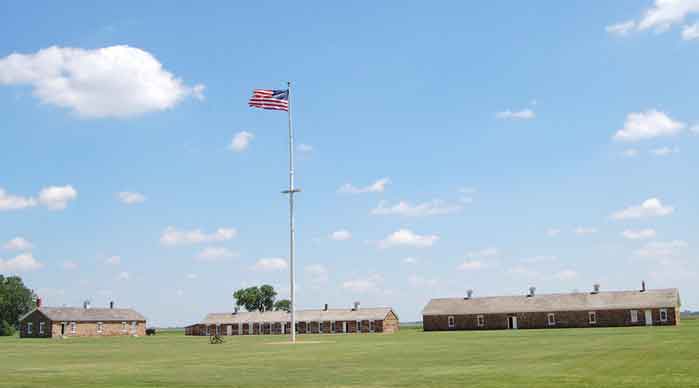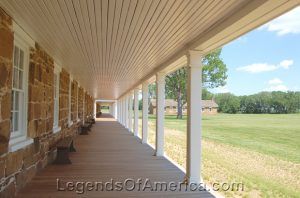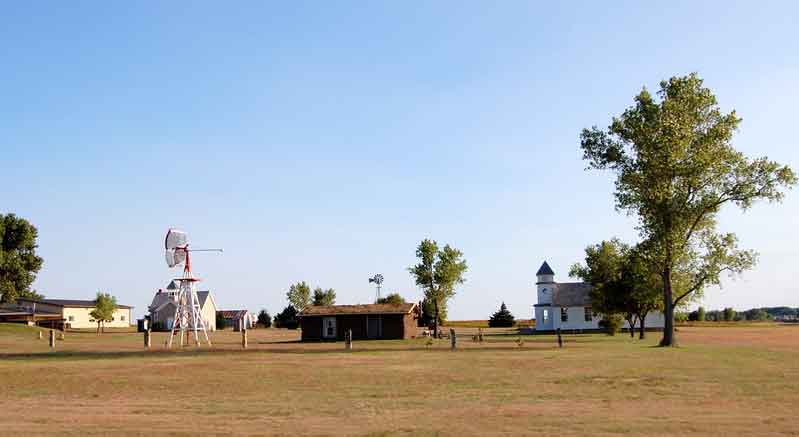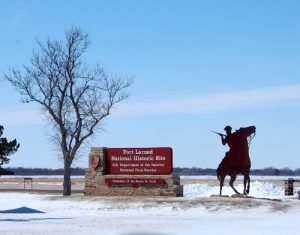About six miles west of Larned, Kansas, the Fort Larned National Historic Site preserves the 1859 military post of Fort Larned. In October of 1859, Captain George H. Stewart, commanding Company K of the First United States Cavalry, was sent out with his company to establish a mail escort station on the line of the Santa Fe Trail. On October 22, he selected a site on the south bank of Pawnee Fork, eight miles from the mouth of the river, and established a camp, which was first called the “Camp on Pawnee Fork.” The original structure was built of sod in the heart of Indian hunting grounds.
On February 1, 1860, the camp was renamed “Camp Alert,” and just a few months later, it moved 2.5 miles west on May 29, 1860, and was renamed again to Fort Larned, in honor of Colonel B. F. Larned, the current paymaster-general of the United States Army.
The reservation initially encompassed a four-mile-square tract of land, but it would be years before it was developed extensively. Its objectives grew as it protected traffic along the Santa Fe Trail and served as a base for military operations against hostile Indians.
In 1861, it also became the Indian Agency for the administration of the Southern Plains Indians under the Bureau of Indian Affairs, pursuant to the Fort Wise Treaty of 1861. In addition to seeking peace with the Indians, it provided a more centralized mechanism for distributing annuities to them.
Until 1862, the post was garrisoned only by a small number of troops and could not prevent many attacks on wagon trains by the Kiowa, Apache, and Arapaho tribes. However, that year, they were reinforced by Colorado and Kansas Volunteers and could better defend the Santa Fe Trail.
In 1865, Fort Larned began rebuilding its structures with adobe, and just two years later, in November 1867, the Department of Missouri ordered that more permanent sandstone buildings be erected. Completed in 1868, the post included officers’ quarters, barracks, a hospital, a blockhouse, and stables.
In the late 1860s, Fort Larned became a key post during the Indian Wars, provided military protection for federal land surveys, and emerged as a significant federal commissary for supplying the increasing number of Indian agencies in Indian Territory south of Kansas. It also participated in several treaties, including the Medicine Lodge Treaty of 1867. At the time, the fort was exceeded in importance only by Forts Leavenworth and Riley. During these critical times, the fort hosted several notable figures, including Kit Carson, Buffalo Bill Cody, General George Armstrong Custer, and other prominent Indian fighters. From 1867 to 1869, the 10th U.S. Cavalry, an African-American regiment more familiarly known as Buffalo Soldiers, was stationed at the post.
In early 1870, frame additions were made for the junior officers, and further improvements were made in 1872, when the Atchison, Topeka & Santa Fe Railroad was completed to the fort. By 1878, however, the Indians had been relocated to various reservations, and the communities of Larned, La Crosse, and Kinsley had been established to serve the area’s farmers and ranchers. The Army deactivated the post in June and abandoned it on July 19, 1878.
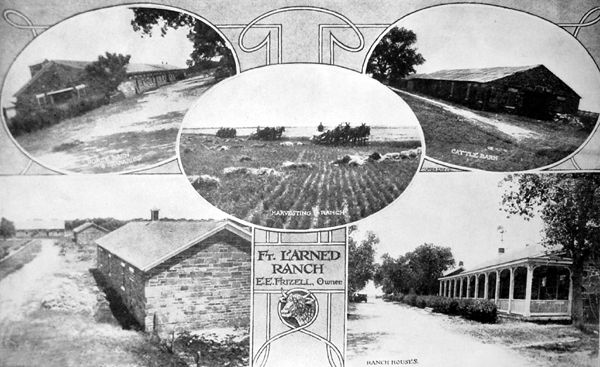
Fort Larned Ranch
In January 1880, Senator Plumb, from the Committee on Military Affairs, recommended passing a bill to sell the reservation to area settlers.
Though the bill did not pass at the time, Congress later approved an act on August 4, 1882, which directed the Secretary of War “to relinquish and turn over to the Department of the Interior, to the public domain, the Fort Larned reservation, to be sold to actual settlers at the appraised price, not more than a quarter-section to any one purchaser.”
The land and buildings were then sold, and the property was privately owned for the next 80 years. Remarkably, the buildings remained intact, and in August 1964, Fort Larned became a National Historic Site and a unit of the National Park System.
The buildings were subsequently extensively restored; one of them became a museum and gift shop. Unfortunately, the oldest building, the hexagon-shaped blockhouse, was demolished years ago and rebuilt in 1988, partly using stones from the original structure.
Today, the National Historic Site displays nine restored buildings, including officers’ quarters, barracks, a blacksmith shop, a commissary, and more. It is one of the best examples of forts from the Indian Wars period. Many of the buildings feature period furnishings, and the Visitor Center includes a museum, an introductory slide show, a library, restrooms, and a gift shop. A nature trail still provides views of wagon ruts left in the ground by the many pioneers who traveled the Santa Fe Trail.
Various programs are available throughout the summer months, where historians in period clothing staff the buildings and provide demonstrations.
Fort Larned is located six miles west of Larned, Kansas, on Highway 156.
Contact Information:
Fort Larned National Historic Site
1767 Kansas Highway 156
Larned, Kansas 67550-9321
620-285-6911

